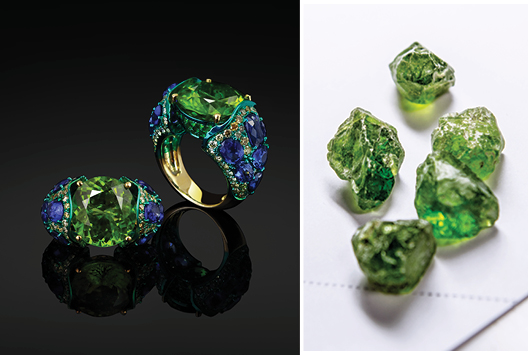
Peridot has been around since the early Egyptians. Yet despite its zinging lemony-green brilliance, this is a little-known gemstone whose appeal has slipped in and out of vogue over the centuries. Today, its fortunes seem to be changing thanks to a surge in the popularity of Pakistan- and Myanmar-sourced specimens and a recent discovery in the Changbai mountains of China.
Peridot is the gem form of olivine, created deep in the earth’s mantle before volcanic activity propels it to the surface. While olivine is abundant, gem-quality peridot is rare, especially in larger stones.
Some 3,500 years ago, the Egyptians fashioned beads out of peridot that came from the Red Sea volcanic island of Zabargad. The gem was believed to have the power to protect against evil spirits. The sultans of the Ottoman Empire amassed one of the world’s largest collections of peridot, which is now on display at the Topkapi Palace Museum in Istanbul, Turkey. Peridot pops up at London’s Victoria & Albert Museum in a 1540s-era jewel and pieces from the Arts & Crafts and Art Nouveau movements. It was also British King Edward VIII’s good luck stone.
Back in the spotlight
Aside from brief flashes in the limelight — including in some jazzy Art Deco pieces from Cartier, and in the jewelry boxes of actress Elizabeth Taylor and philanthropist Peggy Rockefeller — peridot’s popularity has been checkered.
However, the August birthstone is now making a comeback in Pomellato’s debut high-jewelry collection, La Gioia di Pomellato, and was one of the go-to gemstones for the rainbow-colored necklaces in Bulgari’s new Barocko line. Peridot’s more acidic-green tones contrast beautifully with amethyst in the Bulgari high-jewelry collection, and counterbalance the cool shimmer of blue topaz in a pair of Kiki McDonough earrings that the UK’s duchess of Cambridge has worn.
Tones range from bright yellow-green, lime and pure green, to brownish-green and the most valued shade, dark olive-green, depending on the amount of iron in the stone’s composition. Yellow gold settings enhance its brilliance. Peridot appears in collections from Ara Vartanian, Margot McKinney, Temple St. Clair, Tayma Page Allies, Nadine Aysoy, and Austy Lee — the last a committed colorist who uses peridots from Burma, Pakistan and Arkansas. David Webb chooses a deeper olive-toned peridot for bold combinations with rubies, turquoise, kunzite and amethyst. Its electrifying hue makes it a must-have in the palette of any jeweler with an eye for color.
Fuli operational
The principal sources of peridot are the mountains of Pakistan, Myanmar, Arizona and China. “Pakistan peridots come in sizes up to 100 carats cut and have a vibrant, saturated green that is crystal-clear and beautiful in the medium-size and big stones,” says colored-gem specialist Constantin Wild. Myanmar peridots are beautiful, too, he continues — “a slight touch toward a bluish-green and usually with silk-like inclusions that give them a soft overall appearance. They also occur occasionally in sizes up to 100 carats.”
The newest find is in China’s Jilin province, where a 301-carat rough was uncovered in the core sampling. Located in the middle of a protected mountain forest, this deposit was discovered in the 1960s, but only now is mining getting under way. Fuli Gemstones, the company running the project, will be producing branded cut peridots ranging from 1 to 10 carats.
The vision of Fuli Gemstones chairman Haiyang Yu is to work with the industry and nurture young design talent in order to shine a spotlight on peridot.
“Peridot has historically been mined since Egyptian times, but it has been forgotten,” says Yu. “We believe that with the passion and drive both the Fuli team and international designers have for this vibrant green gemstone, we can bring peridot back to its rightful position and hold it in as high regard for its natural beauty [as] the Egyptians did.”
Fuli will cut and polish the stones as well to facilitate traceability, explains Yu, who has a background in jade mining. “We will be committing to ethical practices, reducing the environmental impact of our activities, increasing our traceability and transparency throughout our supply chain. The industry and end consumers want to know that the gemstones are brought to market in the right manner, respecting the people and the environment.”
Pinkie rings and parures
One of the first designers to use Fuli peridot is London-based Liv Luttrell, who is known for her bold, sculptural designs and working with unusual stones. She fell for a striking green gemstone of 3.94 carats and decided to use it for a pinkie ring. The color, she says, “is really accentuated by a brilliant cut, which gives the tone so much life and sparkle and looks amazing in a deliciously large size.”
Peridot’s “seductive hues and clarity have made it a strong competitor of tourmaline and emerald,” says Wild. “In commercial sizes (up to 10 millimeters), it is rather moderately priced for the beauty of the gem. Depending on size and cut, [it goes for around] $100 per carat.” Oval and cushion cuts are ideal because of the gem’s even color, he adds. “Rounds, marquise, trilliant...look great, too.”
Big cabochon peridots featured in Pomellato rings back in the 1990s, with the aim of showing off their visible inclusions, recalls creative director Vincenzo Castaldo, who has a personal fondness for green stones. He has used Himalayan peridot in three parures for the La Gioia collection, each showcasing different tones of the gem — from absinthe to minty green. The biggest challenge of the three: “The breathtaking family of Moghul-cut cabochon peridots in the Gourmette Assoluta was not easy to collect. Volumes are generous, and color is vivid and intense.” The result is a glorious testament to peridot’s beauty.
Article from the Rapaport Magazine - November 2020. To subscribe click here.